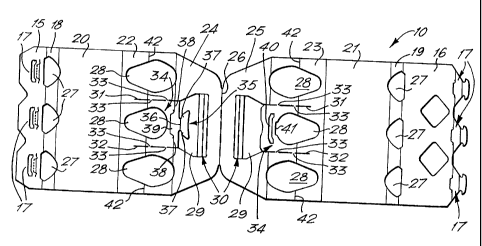Some of the information on this Web page has been provided by external sources. The Government of Canada is not responsible for the accuracy, reliability or currency of the information supplied by external sources. Users wishing to rely upon this information should consult directly with the source of the information. Content provided by external sources is not subject to official languages, privacy and accessibility requirements.
Any discrepancies in the text and image of the Claims and Abstract are due to differing posting times. Text of the Claims and Abstract are posted:
| (12) Patent: | (11) CA 2216515 |
|---|---|
| (54) English Title: | BOTTLE CARRYING ARRANGEMENT |
| (54) French Title: | CONFIGURATION EN PORTE-BOUTEILLES |
| Status: | Deemed expired |
| (51) International Patent Classification (IPC): |
|
|---|---|
| (72) Inventors : |
|
| (73) Owners : |
|
| (71) Applicants : |
|
| (74) Agent: | GOWLING WLG (CANADA) LLP |
| (74) Associate agent: | |
| (45) Issued: | 2006-04-11 |
| (86) PCT Filing Date: | 1997-02-12 |
| (87) Open to Public Inspection: | 1997-08-21 |
| Examination requested: | 2002-01-28 |
| Availability of licence: | N/A |
| (25) Language of filing: | English |
| Patent Cooperation Treaty (PCT): | Yes |
|---|---|
| (86) PCT Filing Number: | PCT/GB1997/000375 |
| (87) International Publication Number: | WO1997/029973 |
| (85) National Entry: | 1997-09-26 |
| (30) Application Priority Data: | ||||||
|---|---|---|---|---|---|---|
|
There is provided a paperboard device made from a blank (10) having two base
panels (15, 16) for connection together, two side
walls (20, 21), two top panels (22, 23), and two handle panels (24, 25) which
are hingedly connected together by fold (26). The top panels
(22, 23) have apertures (28) for receiving necks of bottles to be retained by
the device. The top panels also have flap sections (34), one of
which has a tab (35) which, in use, extends through one of the apertures (28)
in the other top panel (23) and is bent up and retained there
by the neck of the bottle in that aperture.
La présente invention concerne un dispositif en carton réalisé à partir d'une ébauche (10) constituée de deux panneaux de base (15, 16) à raccorder ensemble, de deux panneaux latéraux (20, 21), de deux panneaux de dessus (22, 23), et de deux panneaux de poignée (24, 25) se réunissant en un pli (26) formant charnière. Les panneaux de dessus (22, 23) présentent des orifices (28) permettant d'accueillir les goulots des bouteilles à immobiliser dans le dispositif. Les panneaux de dessus comportent également des rabats (34) dont l'un est équipé d'une languette (35) qui, en utilisation, passe par l'un des orifices (28) ménagés dans l'autre panneau de dessus (23), s'y redresse et y reste bloquée sous l'effet du passage du goulot dans l'orifice.
Note: Claims are shown in the official language in which they were submitted.
Note: Descriptions are shown in the official language in which they were submitted.

For a clearer understanding of the status of the application/patent presented on this page, the site Disclaimer , as well as the definitions for Patent , Administrative Status , Maintenance Fee and Payment History should be consulted.
| Title | Date |
|---|---|
| Forecasted Issue Date | 2006-04-11 |
| (86) PCT Filing Date | 1997-02-12 |
| (87) PCT Publication Date | 1997-08-21 |
| (85) National Entry | 1997-09-26 |
| Examination Requested | 2002-01-28 |
| (45) Issued | 2006-04-11 |
| Deemed Expired | 2008-02-12 |
There is no abandonment history.
| Fee Type | Anniversary Year | Due Date | Amount Paid | Paid Date |
|---|---|---|---|---|
| Registration of a document - section 124 | $100.00 | 1997-09-26 | ||
| Application Fee | $300.00 | 1997-09-26 | ||
| Maintenance Fee - Application - New Act | 2 | 1999-02-12 | $100.00 | 1999-02-01 |
| Maintenance Fee - Application - New Act | 3 | 2000-02-14 | $100.00 | 2000-01-20 |
| Maintenance Fee - Application - New Act | 4 | 2001-02-12 | $100.00 | 2001-01-18 |
| Maintenance Fee - Application - New Act | 5 | 2002-02-12 | $150.00 | 2002-01-23 |
| Request for Examination | $400.00 | 2002-01-28 | ||
| Maintenance Fee - Application - New Act | 6 | 2003-02-12 | $150.00 | 2003-01-24 |
| Maintenance Fee - Application - New Act | 7 | 2004-02-12 | $200.00 | 2004-01-30 |
| Maintenance Fee - Application - New Act | 8 | 2005-02-14 | $200.00 | 2005-01-21 |
| Registration of a document - section 124 | $100.00 | 2005-06-22 | ||
| Final Fee | $300.00 | 2006-01-13 | ||
| Maintenance Fee - Application - New Act | 9 | 2006-02-13 | $200.00 | 2006-01-19 |
Note: Records showing the ownership history in alphabetical order.
| Current Owners on Record |
|---|
| GRAPHIC PACKAGING INTERNATIONAL, INC. |
| Past Owners on Record |
|---|
| NEGELEN, EMANUEL |
| RIVERWOOD INTERNATIONAL CORPORATION |